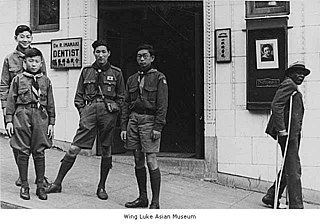
Scouting in Nebraska has a long history, from the 1910s to the present day, serving thousands of youth in programs that suit the environment in which they live.

Scouting in Washington has a long history, from the 1910s to the present day, serving thousands of youth in programs that suit the environment in which they live.

Scouting in Iowa has a long history, from the 1910s to the present day, serving thousands of youth in programs that suit the environment in which they live.

Scouting in Missouri has a long history, from the 1910s to the present day.

Scouting in Arkansas has a long history, from 1913 to the present day, serving thousands of youth in programs that suit the environment in which they live.

Scouting in Louisiana has a long history, from the 1910s to the present day, serving thousands of youth in programs that suit the environment in which they live.

Scouting in Mississippi has a long history, from the 1910s to the present day, serving thousands of youth in programs that suit the environment in which they live.

Wisconsin has a long history with the Boy Scout and Girl Scout organizations from the 1910s to the present day, both programs have independently served thousands of youth in programs that suit the environment in which they live.

Scouting in Illinois has served youth since 1909. The state was the home of the Boy Scouts of America (BSA) founder, William D. Boyce.

Scouting in Ohio has a long history, from the 1908 to the present day, serving thousands of youth in programs that suit the environment in which they live.

Silicon Valley Monterey Bay Council (#055) is a Boy Scouts of America council headquartered in San Jose, California. It was the result of a council merger between the Santa Clara County Council and the Monterey Bay Area Council. In 2004, the previous two councils served over 11,000 youth in over 400 Boy Scout troops, Cub Scout packs, Venturing crews, and Explorer posts. In 2012, the Monterey Bay Area Council announced that after 89 years as a separate council, it had agreed to merge back into the Santa Clara County Council. As of 2013, the council served 13,000 youth in four different counties.

Westchester–Putnam Council was a local council of the Boy Scouts of America, serving Boy Scouts in southeastern New York State. It merged with the Hudson Valley Council in January 2021 to become the Greater Hudson Valley Council.

The Mid Iowa Council is a council of the Boy Scouts of America that serves all Scouts, adult volunteers and Venturers in Central Iowa. This includes the area of the state capital, Des Moines.

Samoset Council is a Boy Scout council headquartered in Weston, Wisconsin that serves north central Wisconsin. Founded in 1920, the council gets its name from an early Boy Scout camp in the Town of Harrison named Camp Sam-O-Set. The council is served by Tom Kita Chara Lodge of the Order of the Arrow.

The Lincoln Heritage Council (LHC) is a local council of the Boy Scouts of America serving 64 counties in four states: Kentucky, Indiana, Illinois, and Tennessee.

The Winnebago Council is a council of the Boy Scouts of America (#173). The Winnebago Council serves Scouts BSA, Cub Scouts, adult volunteers and Venturers in 17 counties located in North Central Iowa. Including: Black Hawk, Grundy, Butler, Franklin, Wright, Hancock, Winnebago, Worth, Cerro Gordo, Mitchell, Floyd, Bremer, Chickasaw, Howard, Winneshiek, Fayette, and Buchanan.

The Mid-America Council of the Boy Scouts of America offers programs in 58 counties in Nebraska, Iowa and South Dakota. The Mid-America Council was formed from a merger of the Covered Wagon Council and the Southwest Iowa Council in 1965. The first recorded Council in the area was in 1918 as the Omaha Council. In 2000 the council merged with the Prairie Gold Council that had been located in Sioux City, Iowa.

Three Harbors Council is a local council of the Boy Scouts of America serving three southeastern Wisconsin counties: Milwaukee County, Racine County, and Kenosha County. Its name and logo refer to the three major port cities of Milwaukee, Racine, and Kenosha on Lake Michigan.

Water and Woods Field Service Council was a field service council of the Michigan Crossroads Council that served youth in the central and northeastern Lower Peninsula of Michigan. The Council was headquartered in Flint, Michigan, with service centers located in Auburn, Lansing, and Port Huron. The Water and Woods Field Service Council was the result of a merger in 2012 of Lake Huron Area Council, Blue Water Council, Tall Pine Council and Chief Okemos Council.
The W. D. Boyce Council of the Boy Scouts of America serves youth in central Illinois, from Lincoln to Ottawa, and Peoria to Bloomington.



















